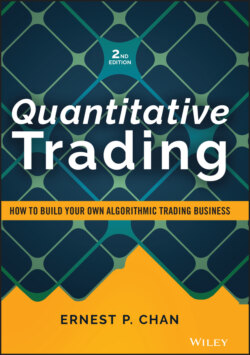Читать книгу Quantitative Trading - Ernest P. Chan - Страница 26
How Will Transaction Costs Affect the Strategy?
ОглавлениеEvery time a strategy buys and sells a security, it incurs a transaction cost. The more frequently it trades, the larger the impact of transaction costs will be on the profitability of the strategy. These transaction costs are not just due to commission fees charged by the broker. There will also be the cost of liquidity—when you buy and sell securities at their market prices, you are paying the bid–ask spread. If you buy and sell securities using limit orders, however, you avoid the liquidity costs but incur opportunity costs. This is because your limit orders may not be executed, and therefore you may miss out on the potential profits of your trade. Also, when you buy or sell a large chunk of securities, you will not be able to complete the transaction without impacting the prices at which this transaction is done. (Sometimes just displaying a bid to buy a large number of shares for a stock can move the prices higher without your having bought a single share yet!) This effect on the market prices due to your own order is called market impact, and it can contribute to a large part of the total transaction cost when the security is not very liquid.
Finally, there can be a delay between the time your program transmits an order to your brokerage and the time it is executed at the exchange, due to delays on the internet or various software-related issues. This delay can cause a slippage, the difference between the price that triggers the order and the execution price. Of course, this slippage can be of either sign, but on average it will be a cost rather than a gain to the trader. (If you find that it is a gain on average, you should change your program to deliberately delay the transmission of the order by a few seconds!)
Transaction costs vary widely for different kinds of securities. You can typically estimate it by taking half the average bid–ask spread of a security and then adding the commission if your order size is not much bigger than the average sizes of the best bid and offer. If you are trading S&P 500 stocks, for example, the average transaction cost (excluding commissions, which depend on your brokerage) would be about 5 basis points (that is, five-hundredths of a percent). Note that I count a round-trip transaction of a buy and then a sell as two transactions—hence, a round trip will cost 10 basis points in this example. If you are trading ES, the E-mini S&P 500 futures, the transaction cost will be about 1 basis point. Sometimes the authors whose strategies you read about will disclose that they have included transaction costs in their backtest performance, but more often they will not. If they haven't, then you just to have to assume that the results are before transactions, and apply your own judgment to its validity.
As an example of the impact of transaction costs on a strategy, consider this simple mean-reverting strategy on ES. It is based on Bollinger Bands: that is, every time the price exceeds plus or minus 2 moving standard deviations of its moving average, short or buy, respectively. Exit the position when the price reverts back to within 1 moving standard deviation of the moving average. If you allow yourself to enter and exit every five minutes, you will find that the Sharpe ratio is about 3 without transaction costs—very excellent indeed! Unfortunately, the Sharpe ratio is reduced to –3 if we subtract 1 basis point as transaction costs, making it a very unprofitable strategy.
For another example of the impact of transaction costs, see Example 3.7.
